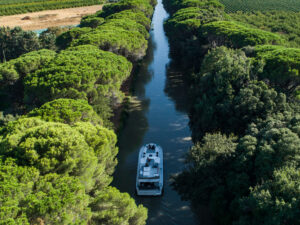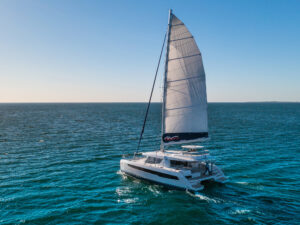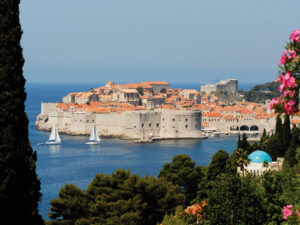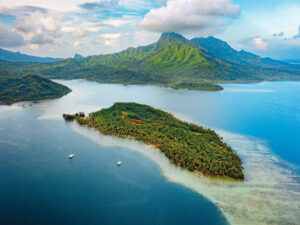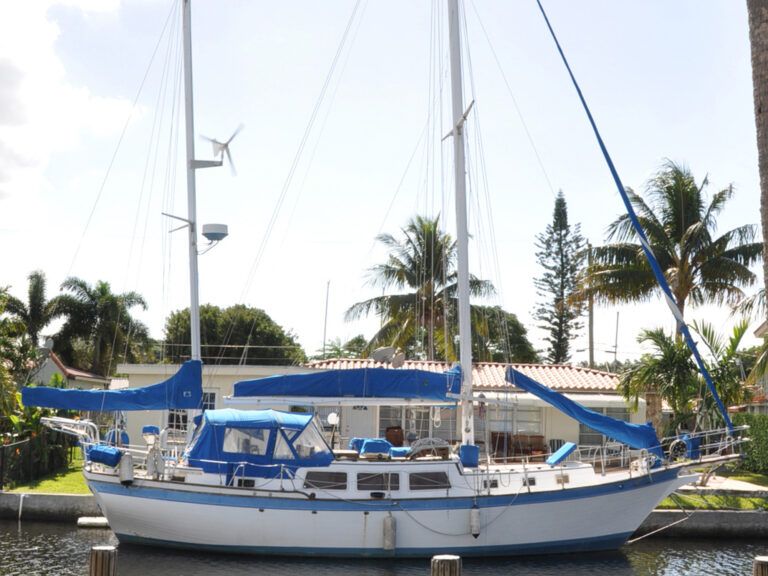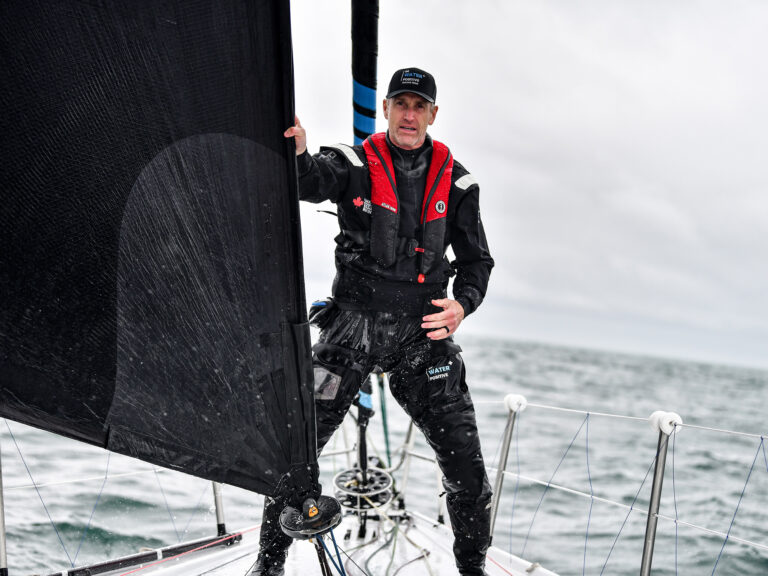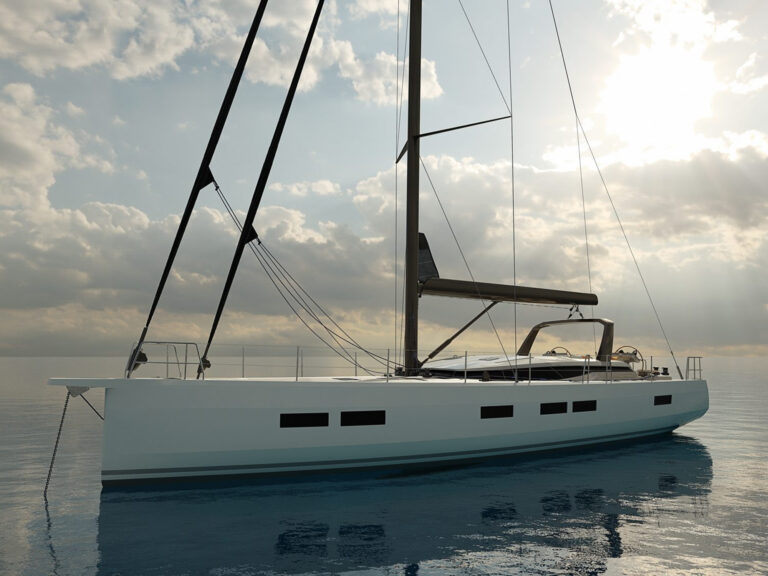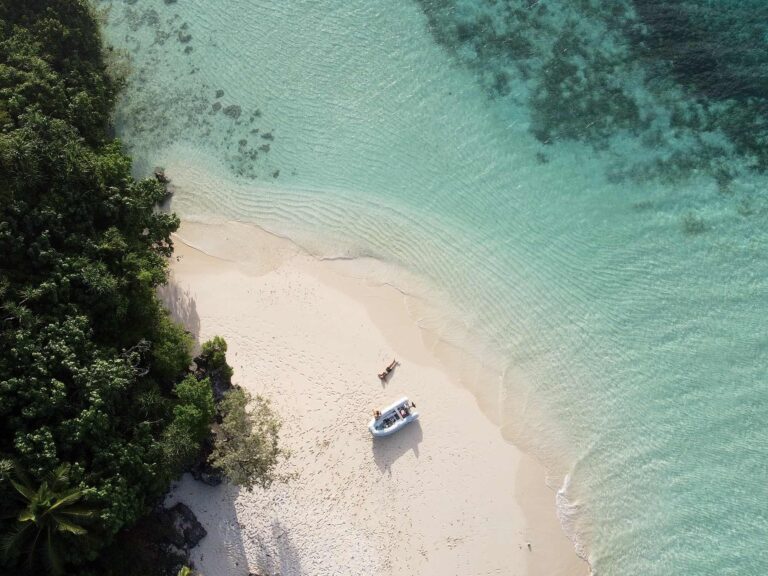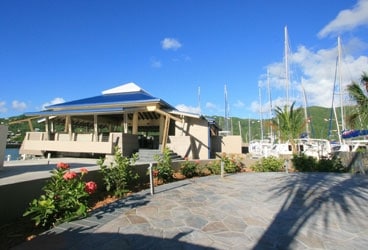
Moorings new base 368
The charter company with the reputation for offering award-winning yachts to vacationing sailors now intends to deliver five-star service before and after their trips, too.
As The Moorings marks its 40th year of helping mariners have fun under sail, it’s also putting the finishing touches on a $15 million expansion and renovation of its flagship base at Road Town, Tortola, in the British Virgin Islands. According to The Moorings, the base is the largest such facility in the world.
Grabbing a chance to visit this unique sailing venue and catch up with old friends made when I worked in the Caribbean as crew aboard a private yacht, I accepted an offer for a sneak preview. It was the highlight of an already-perfect working holiday, notwithstanding the prompt arrival of Christmas 2008’s winds and squalls.
Over a period of two and a half years, I learned, The Moorings sought and received permission from the B.V.I. government to expand the original marina, built in 1976, and extend the docks. It enlarged and renovated the Mariner Inn Hotel and added Charlie’s Bar and Restaurant, which is perched over the water and named after the company’s beloved late founder, Charlie Cary. It has also added upscale amenities, from chart briefings in an air-conditioned conference room aided by digital readouts on a flat-screen TV to concierge, spa, and salon treatments.
“That seven days of vacation is crucial for us to get it right, and we’re striving to ensure the entire experience,” Peter Cochran, vice president of global operations for The Moorings, told me. “We’re focusing as much on the people side as on the boats. There’s four hours of human contact before the charter starts, and that gives us four hours to impart the wow factor to our customers.”
The premium service-the wow factor-starts when guests are picked up at the airport or at one of the ferry terminals. Luggage disappears, and bottles of water are distributed. Upon reaching the base, it’s time for complimentary rum punches. Customer-service manager Greg George’s team encourages arrivals to choose from a number of amenities; staff members manning reception and concierge desks greet them and help make restaurant reservations or handle queries of any sort. “At this facility, we want to take a more ambassadorial approach,” George said. “If we don’t know your name when you get here, we’re failing.”
Cochran calls this process the “customer journey,” and he and George showed me around the grounds as if I were about to embark on my own charter. We strolled through the airy, tropically landscaped Moorings entrance and were surrounded by high ceilings, muted paint tones, and soft breezes wafting through a modern reception area of furniture with Sunbrella-covered cushions.
The sensation of peace and calm here was enhanced by the relative quiet. The docks, which had largely emptied out over the busy holiday weekend, are closer than they seemed from this haven, yet I could imagine the staff’s full-court press to get hundreds of holiday charters off. “You’re immediately in the relax zone here,” Cochran said, adding, with pride, that “this is The Mooring brand, and you’re here. First impressions count.”
We then walked up a set of stairs that climb around a beautiful tropical rain forest container garden, a mood adjustor to the end point of our stroll-private massage-treatment rooms for individuals and couples. Back down the stairs, we entered the air-conditioned, elegantly appointed bathrooms.
For sailors jonesing for coffee and tea lounges back home, fear not: Our next stop was an upscale lounge-and-food area that also offers a dozen flavors of gelato. Not in the mood for ice cream or caffeine? Browse merchandise at the shop next door. In the mood for a little more serious shopping? The Moorings has even installed a brokerage office, should a customer decide to buy a yacht on the spot and add it to the worldwide fleet.
Project manager Tanya Whistler also joined us; her personal story is a quintessential company tale in an operation that emphasizes long-term relationships with its workers. No sooner had Whistler begun to detail her role in the renovation of the existing Mariner Inn Hotel than Cochran divulged the inside story.
As the three of us inspected the rooms, Cochran told me how Captain Hugh Whistler, Tanya’s father, helped Moorings founder Cary construct the original flagship base at Road Town 40 years ago. While he worked, Tanya scrubbed dinghies for a few bucks. Years later, after she returned home from school abroad, she went to work for Sunsail. She never saw it coming, but, following in the footsteps of her father, in 2006 she was appointed project manager of The Moorings project.
Whistler’s B.V.I. origins and family legacy helped forge beneficial relationships for her. But it was soon clear to me that it’s her dedication that’s earned her the respect of island officials and hundreds of workers and contractors, most of whom are men.
She takes it all in stride and is proud of her efforts, particularly the improvements to the Mariner Inn Hotel, which she ordered gutted and completely renovated. But Whistler is graced with a self-effacing manner, and her comments remain low-key: “You learn to live here and really enjoy it,” she told me.
Another key Moorings employee with a company tale is regional manager Clarence Malone, who’s in charge of the entire Tortola operation. Cary hired him 34 years ago as a boat cleaner, and he’s worked his way up from there at the Road Town base. The years of employment have instilled in Malone a passion about the company product, and he joined Whistler, Cochran, and me as we headed to the hotel.
The spacious new rooms they unveiled include WiFi, iPod docking stations, Bose sound systems, coffee and espresso machines, and bathtubs with captivating views. Whistler and Cochran slid a tub’s glass door open and told me to choose between a sea view of Road Harbour and Sir Francis Drake Channel lying beyond or the latest news and sports scores on the massive flat-screen TV mounted on the wall.
The project reflects strengthened financial commitment by corporate parent TUI Marine as well as The Moorings’ increasing presence in the power, crewed, and sailing-school markets, in addition to its longstanding dominance in the premium-service bareboat market favored by Americans in the middle to higher end of the income demographic. “We weren’t going to cut corners on this project,” Cochran told me over lunch. “Our customers and yacht owners supply great feedback and are quick to tell us when it’s good and not so good.”
Yacht designs favored by this mix of clientele and fleet owners include Beneteau monohulls, the Robertson & Caine-built Moorings 4600 catamaran as well as its 372 and 474 powercats. The bareboat fleet, according to Cochran, numbers 180, a combination of monohulls and multihulls; the crewed fleet stands at 20, and the power fleet at 16.
More weighty imperatives also drove the project. “In terms of sustainable tourism, you can’t not think about the environment and our impact upon it,” Cochran said. The Moorings’ Crystal Green strategy combines environmental initiatives and best practices company-wide. The result is apparent, from the use of recycled wall tiles to “plicker” furniture, Cochran and Whistler’s term for a modern, durable plastic furniture that looks like wicker and is in use throughout the base.
But the initiatives reach beyond furniture and tiles. The base now boasts a two-part water-quality system that Cochran says is allowing sea life to return and propagate in an inner harbor once infamous for its polluted state. By restructuring the breakwater, the company also added culverts to allow extra flow in and out of the inner harbor. It also installed a pump that flushes 50 million gallons from the sea through a pipe that runs under the water at the base, displacing stagnant water.
Other innovations include using biodegradable soaps for cleaning boats and the base, using recycled water for laundry as well as for boat washdown, the daily creation of 50,000 gallons of desalinated water, and the use of low-toxin copper-based bottom paints. And instead of relying on sand-screw moorings, the company installed Manta Ray mooring systems that use vertical chain placement, which reduces damage to the sea floor.
Among ongoing best practices for employees is training for fueling boats without losing fuel on deck or into the water and for handling oil spills.
“What we’ve tried to do is understand today what the customer wants more of tomorrow,” Cochran told me before I headed out to see more old friends. “We offer the best products-crewed, bareboat, power, the sailing school. We’re partners with the B.V.I. government. We’ve just continued Charlie’s vision. It’s a bit of a legacy to be part of what’s so far the best charter base in the world.”
Managing editor Elaine Lembo writes about chartering for CW.

